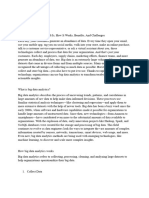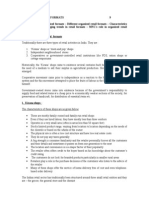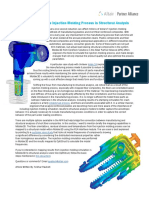0 ratings0% found this document useful (0 votes)
21 viewsNeed of Big Data
Need of Big Data
Uploaded by
laiba sajjadbig data need.
Copyright:
© All Rights Reserved
Available Formats
Download as DOCX, PDF, TXT or read online from Scribd
Need of Big Data
Need of Big Data
Uploaded by
laiba sajjad0 ratings0% found this document useful (0 votes)
21 views5 pagesbig data need.
Original Title
Need of big data (Autosaved)
Copyright
© © All Rights Reserved
Available Formats
DOCX, PDF, TXT or read online from Scribd
Share this document
Did you find this document useful?
Is this content inappropriate?
big data need.
Copyright:
© All Rights Reserved
Available Formats
Download as DOCX, PDF, TXT or read online from Scribd
Download as docx, pdf, or txt
0 ratings0% found this document useful (0 votes)
21 views5 pagesNeed of Big Data
Need of Big Data
Uploaded by
laiba sajjadbig data need.
Copyright:
© All Rights Reserved
Available Formats
Download as DOCX, PDF, TXT or read online from Scribd
Download as docx, pdf, or txt
You are on page 1of 5
Need of big data:
Big data sets are generally huge – measuring tens of terabytes
It follows basic logic: The more you know about a problem or issue, the more reliable the solution.
In other words, big data is an opportunity for businesses to be more thorough in the way they
analyze and understand the world.
Data, in today’s business and technology world, is indispensable. The Big Data technologies and
initiatives are rising to analyze this data for gaining insights that can help in making strategic
decisions. Big data means deeper insights and more certain findings. The breadth of information
provides businesses with more reliable insights and can drive more confident decisions.In recent
years, the rapid development of Internet, Internet of Things, and Cloud Computing have led to the
explosive growth of data in almost every industry and business area.
In digital world, data are generated from various sources and the fast transition from digital
technologies has led to growth of big data. It provides evolutionary breakthroughs in many fields
with collection of large datasets
STRUCTURED,UNSTRUCTURED, AND SEMISTRUCTURED BIG DATA SETS:
The term big data was preceded by very large databases (VLDBs) which were managed using
database management systems (DBMS). Today, big data falls under three categories of data sets
– structured, unstructured and semi-structured.
Structured data sets:
Comprise of data which can be used in its original form to derive results. Examples include
relational data such as employee salary records. Most modern computers and applications are
programmed to generate structured data in preset formats to make it easier to process.
Unstructured data sets:
On the other hand, are without proper formatting and alignment. Examples include human texts,
Google search result outputs, etc. These random collections of data sets require more processing
power and time for conversion into structured data sets so that they can help in deriving tangible
results.
Semi-Structured data sets:
Are a combination of both structured and unstructured data. These data sets might have a proper
structure and yet lack defining elements for sorting and processing. Examples include RFID and
XML data sets.
How Big Data Is Used in Businesses:
Big data analytics is done using advanced software systems. This allows businesses to reduce the
analytics time for speedy decision making. Basically, the modern big data analytics systems allow
for speedy and efficient analytical procedures. This ability to work faster and achieve agility offers
a competitive advantage to businesses. In the meantime, businesses enjoy lower cost using big data
analytics software.
COCA COLA:
Real example of a company that uses big data analytics to drive customer retention is Coca-Cola.
In the year 2015, Coca-Cola managed to strengthen its data strategy by building a digital-led
loyalty program. IN AN INTERVIEW COCA COLA’S DIRECTOR OF STRTEGY said :Data is
also helping us create more relevant content for different audiences. We want to focus on creating
advertising content that speaks differently to different audiences. Some people love music. Other
people watch every sport no matter what time of year. Our brands are already visible in those
spaces, and we’re working hard to use data to bring branded content that aligns with people’s
passions
Born Digital Data
It is the information which has been captured through a digital medium, e.g. a computer or
smartphone app, etc. This type of data has an ever expanding range since systems keep on
collecting different kinds of information from users. Born digital data is traceable and can provide
both personal and demographic business insights.
Examples include Cookies, Web Analytics and GPS tracking.
NETFLIX:
An example of a big brand that uses big data analytics for targeted advertising is NETFLIX. With
over 100 million subscribers, the company collects huge data, which is the key to achieving the
industry status Netflix boosts. If you are a subscriber, you are familiar to how they send you
suggestions of the next movie you should watch. Basically, this is done using your past search and
watch data. This data is used to give them insights on what interests the subscriber most.
Big Data Analytics for Risk Management:
Risk management plan is a critical investment for any business regardless of the sector. Being
able to fore see a potential risk and mitigating it before it occurs is critical if the business is to
remain profitable.Big data analytics has a huge potential for enhancing the quality of risk
management models. Therefore, a business can be able to achieve smarter risk mitigation strategies
and make strategic decisions.
UOB BANK SINGAPORE:
Is an example of a brand that uses big data to drive risk management. UOB bank recently tested
a risk management system that is based on big data. The big data risk management system enables
the bank to reduce the calculation time of the value at risk. Initially, it took about 18 hours, but
with the risk management system that uses big data, it only takes a few minutes. Through this
initiative, the bank will possibly be able to carry out real-time risk analysis in the near future.
AMAZON:
The online retail giant has access to a massive amount of data on its customers; names, addresses,
payments and search histories are all filed away in its data bank.
While this information is obviously put to use in advertising algorithms, Amazon also uses the
information to improve customer relations, an area that many big data users overlook.
Starbucks:
Have you ever wondered how Starbucks can open three branches on the same street and not have
their business suffer?
The coffeehouse behemoth uses big data to determine the potential success of each new location,
taking information on location, traffic, area demographic and customer behaviour into account.
Making this kind of assessment before opening a store means Starbucks can make a fairly accurate
estimation of what the success rate will be and choose locations based on the propensity toward
revenue growth.
IMPORTANCE OF BIG DATA:
Big data analytics helps organizations harness their data and use it to identify new opportunities.
That, in turn, leads to smarter business moves, more efficient operations, higher profits and happier
customers.
Big data means deeper insights and more certain findings. The breadth of information provides
businesses with more reliable insights and can drive more confident decisions.
Cost reduction:
Big data technologies such as Hadoop and cloud-based analytics bring significant cost advantages
when it comes to storing large amounts of data – plus they can identify more efficient ways of
doing business.
Faster, better decision making:
With the speed of Hadoop and in-memory analytics, combined with the ability to analyze new
sources of data, businesses are able to analyze information immediately – and make decisions
based on what they’ve learned.
New products and services:
With the ability to gauge customer needs and satisfaction through analytics comes the power to give
customers what they want. Davenport points out that with big data analytics, more companies are
creating new products to meet customers’ needs.
Helps identify trends to stay competitive:
As mentioned earlier in this post, one of data analytics’ primary objectives is to determine
patterns within large data sets. This is particularly useful for identifying new and emerging
market trends. Once identified these trends could become the key to gaining a competitive
advantage by introducing new products and services.
Helps in selecting target audience:
One of the key value props of big data analytics is how you can shape customer data to provide
more insight into consumer preference and expectations. A deeper analysis of customer data can
help companies in identifying and targeting audience with utmost precision using tailor-made
products and services.
CONLUSION:
The world is moving towards a more connected future, and big data solutions are going
to play a big part in automation and development of AI technologies. Companies like
Google are already using Machine Learning processes for greater precision in delivering
their services. As technologies around the globe become more synchronous and
interoperable, big data will become the core that connects them together. Therefore,
companies using big data solutions need to keep up with its evolving nature while those
still reluctant to invest should rethink their organizational policies. There are a few pointers
which can be helpful in getting the most out of your investment in big data.
Demand a value proposition from big data by investing in adequate
technologies to capture and store data. If you do not have the data, then you do
not have the benefits. Data discovery tools can help you in digging up big data
which is relevant to your business.
Make use of big data to improve and innovate your applications and
services.
Arrange organization-wide training to accustom your staff to big data
solutions and their usage.
Interact and collaborate with big data users from associated fields of
businesses to derive more benefits and bring down usage costs.
Avoid siloed big data management and stay open to integration with shared
enterprise infrastructures.
If shifting to a new data platform, choose those which have a special support
system for big data, such as in-memory processing, MapReduce, etc.
Develop a tech strategy for your organization’s data and lay out a plan for
capturing and processing them in the long-run.
Plan the financials for storage and processing of your big data as well.
Moreover, big data is also resonating with government and public-sector agencies, which
is a good sign for businesses all around the world as this will help deepen the public-
private collaboration in a range of fields.
You might also like
- Mission Statement of BataDocument5 pagesMission Statement of BataArbab Usman Khan0% (1)
- About SamsungDocument44 pagesAbout SamsungHarold Dela Fuente100% (2)
- Final Project Report On LakmeDocument66 pagesFinal Project Report On LakmeJagdish SachdevaNo ratings yet
- The Three Vs of Big DataDocument4 pagesThe Three Vs of Big DataAli AsadNo ratings yet
- Big Data Relevance Retailers 0714 1 PDFDocument14 pagesBig Data Relevance Retailers 0714 1 PDFSai KuNo ratings yet
- Introduction To Big Data Unit - 2Document75 pagesIntroduction To Big Data Unit - 2Sovit ChaudharyNo ratings yet
- UNIT I BIG DATA Extra ContentDocument15 pagesUNIT I BIG DATA Extra Contentantush.fredinaNo ratings yet
- Three V of Big DataDocument4 pagesThree V of Big DataAedrian HarveyNo ratings yet
- Fundamentals of Big Data and Business Analytics - Assignment June 2021 K...Document9 pagesFundamentals of Big Data and Business Analytics - Assignment June 2021 K...Rohit MotsraNo ratings yet
- Why Big Data - Benefits and Importance of Big DataDocument10 pagesWhy Big Data - Benefits and Importance of Big DataRheamar Angel MolinaNo ratings yet
- What Is Big Data & Why Is Big Data Important in Today's EraDocument13 pagesWhat Is Big Data & Why Is Big Data Important in Today's EraMaanit Singal100% (1)
- The Importance of Big Data Analytics in Business: A Case StudyDocument5 pagesThe Importance of Big Data Analytics in Business: A Case StudyPaola ZambranoNo ratings yet
- Chapter 3 Big Data Analytics and Big Data Analytics Techniques PDFDocument22 pagesChapter 3 Big Data Analytics and Big Data Analytics Techniques PDFMamNo ratings yet
- Big Data EssayDocument6 pagesBig Data EssayRodolfo de LeonNo ratings yet
- IoT NOtesDocument34 pagesIoT NOtesManikannan GovindasamyNo ratings yet
- Part E-15 Big DataDocument12 pagesPart E-15 Big DataIfra ReNo ratings yet
- BDL4Document4 pagesBDL4maksut kayaNo ratings yet
- Data Science vs. Big Data vs. Data AnalyticsDocument7 pagesData Science vs. Big Data vs. Data AnalyticsLadines ClarisseNo ratings yet
- Chapter 9 Questions and Case StudyDocument9 pagesChapter 9 Questions and Case Studychris waltersNo ratings yet
- Bda Unit1Document19 pagesBda Unit1samhithaNo ratings yet
- Enterprise integration ReportDocument7 pagesEnterprise integration ReportMohamed NabilNo ratings yet
- Artificial Intelligence Big Data 01 Research PaperDocument32 pagesArtificial Intelligence Big Data 01 Research PapermadhuraNo ratings yet
- The Definition of Big DataDocument7 pagesThe Definition of Big DataLinh NguyenNo ratings yet
- Big DataDocument13 pagesBig DataKarishma HentryNo ratings yet
- MODULE 2, BUSINESS ANALYTICS. Big Data Meets Business AnalyticDocument3 pagesMODULE 2, BUSINESS ANALYTICS. Big Data Meets Business AnalyticAliyha DionioNo ratings yet
- Big Data Analysis GuideDocument11 pagesBig Data Analysis GuideAnonymous DLEF3GvNo ratings yet
- Big DataDocument7 pagesBig DataSundaram yadavNo ratings yet
- What Is Big DataDocument5 pagesWhat Is Big DataShoaib AhmedNo ratings yet
- MergeResult 2024 12 01 08 49 35Document30 pagesMergeResult 2024 12 01 08 49 35Manpreet SinghNo ratings yet
- Big Data AnalyticsDocument19 pagesBig Data AnalyticsRitwik0% (1)
- Big Data AnalyticsDocument73 pagesBig Data Analyticsayushgoud1234No ratings yet
- Big Data IQDocument36 pagesBig Data IQSubhramanyum PatraNo ratings yet
- What Is Big DataDocument8 pagesWhat Is Big Databheng avilaNo ratings yet
- Assignment 1 - Big Data in Big CompaniesDocument5 pagesAssignment 1 - Big Data in Big CompaniesEduardo ResendezNo ratings yet
- Mittal School of Business: Course Code: CAP348 Course Title: Introduction To Big DataDocument6 pagesMittal School of Business: Course Code: CAP348 Course Title: Introduction To Big DataNitin PatidarNo ratings yet
- Big Data Driven E-Commerce Architecture: International Journal of Economics, Commerce and ManagementDocument8 pagesBig Data Driven E-Commerce Architecture: International Journal of Economics, Commerce and Managementhoo zenNo ratings yet
- Big Data ContentDocument7 pagesBig Data Contenthats1234100% (1)
- DocumentDocument5 pagesDocumentyusufmuhammadii013No ratings yet
- Data Analytics-Unit1 NotesDocument30 pagesData Analytics-Unit1 NotesAnuraagNo ratings yet
- Fundamentals of Big Data and Business Analytics AnswersDocument20 pagesFundamentals of Big Data and Business Analytics AnswersNIKHIL ARORANo ratings yet
- Content ForDocument7 pagesContent ForDurga Prasad HNo ratings yet
- Presentation (3) Big DataDocument11 pagesPresentation (3) Big Datamail2document 167No ratings yet
- Unit 5 BDTTDocument19 pagesUnit 5 BDTTAshwathNo ratings yet
- Big Data AnalyticsDocument126 pagesBig Data AnalyticsDisha Sharma100% (1)
- What Is Data AnalyticsDocument16 pagesWhat Is Data AnalyticsOmaR AL-SaffaRNo ratings yet
- GTB Big Data Whitepaper (DB0324) v2 PDFDocument28 pagesGTB Big Data Whitepaper (DB0324) v2 PDFdgnyNo ratings yet
- Unit-1Document11 pagesUnit-1itskuldeepitskuldeep2No ratings yet
- Assignment - Fundamentals of Big Data and Business AnalyticsDocument9 pagesAssignment - Fundamentals of Big Data and Business AnalyticsRanjani SundarNo ratings yet
- Big Data UNIT1Document23 pagesBig Data UNIT1Keshava VarmaNo ratings yet
- Arquitectura de DatosDocument9 pagesArquitectura de DatosjorgecifNo ratings yet
- Big DataDocument9 pagesBig DataJose Antonio Velazquez GarciaNo ratings yet
- The Current and Future Uses of Big DataDocument3 pagesThe Current and Future Uses of Big DatazwubNo ratings yet
- Bigdata Mod-1Document33 pagesBigdata Mod-1preeti sahuNo ratings yet
- Ids Unit IDocument46 pagesIds Unit IOmer SohailNo ratings yet
- Big Data: Management Information SystemsDocument11 pagesBig Data: Management Information SystemsVikas SinghNo ratings yet
- Big Data Analytics - Unit 1Document43 pagesBig Data Analytics - Unit 1Johan TorresNo ratings yet
- Big_Data_Analytics_1718265256Document43 pagesBig_Data_Analytics_1718265256Evelyn JenNo ratings yet
- Benefits of Using Data Analytics ServicesDocument2 pagesBenefits of Using Data Analytics ServicesTotal eBiz SolutionsNo ratings yet
- My BAAssignmentronyDocument10 pagesMy BAAssignmentronyrony kjNo ratings yet
- Unit 1Document54 pagesUnit 1nageswari vNo ratings yet
- Big Data - An Innovative Way To Gain Competitive Advantage Through Converting Data Into KnowledgeDocument4 pagesBig Data - An Innovative Way To Gain Competitive Advantage Through Converting Data Into KnowledgeYana NugrahaNo ratings yet
- Big DataDocument3 pagesBig Datanam trầnNo ratings yet
- Exercise #2 - Irving Oil Case StudyDocument17 pagesExercise #2 - Irving Oil Case StudyOneTonyOneNo ratings yet
- Documents Required For Title TransferDocument3 pagesDocuments Required For Title TransferChaitanya Chaitu CANo ratings yet
- Unit 2 (Retail Management)Document20 pagesUnit 2 (Retail Management)Prem RajNo ratings yet
- Exam # 1 - Review Sheet (Chapters 1 - 9)Document1 pageExam # 1 - Review Sheet (Chapters 1 - 9)mwai joramNo ratings yet
- SegmentationDocument6 pagesSegmentationAda Araña Diocena0% (1)
- Chapter Nature and Scope of Managerial EconomicsDocument24 pagesChapter Nature and Scope of Managerial EconomicsÖnder BalcıNo ratings yet
- St. Roch Market Survey ResultsDocument18 pagesSt. Roch Market Survey ResultsDarla RumleyNo ratings yet
- Redefining: TG Definition & Customized CommunicationDocument9 pagesRedefining: TG Definition & Customized Communicationnetfreak12No ratings yet
- Digital Marketing Channels - The Landscape - NotiteDocument5 pagesDigital Marketing Channels - The Landscape - NotiteionutNo ratings yet
- Nexus Service Marketing SystemDocument26 pagesNexus Service Marketing SystemĐức Thành Ngọc BíchNo ratings yet
- Law of Sale of Goods (Notes)Document9 pagesLaw of Sale of Goods (Notes)Bay Zeng LinNo ratings yet
- Mba - Ed NotesDocument9 pagesMba - Ed NotesVaishnavi Subramanian100% (1)
- Presentation On: Chapter - 3Document54 pagesPresentation On: Chapter - 3rajvee18No ratings yet
- Marketing Plan FinaldanoneDocument25 pagesMarketing Plan FinaldanoneKrunal ShahNo ratings yet
- Tequila TbwaDocument18 pagesTequila Tbwarachita1112No ratings yet
- KPI Examples - Types of Key Performance IndicatorsDocument7 pagesKPI Examples - Types of Key Performance IndicatorsrwillestoneNo ratings yet
- The Influence of The Injection Molding Process in Structural AnalysisDocument1 pageThe Influence of The Injection Molding Process in Structural Analysiseduardo_umNo ratings yet
- A Senior Essay Submitted To Management Department in Partial Fulfillment of The Requirement For Bachlor of Art Degree in ManagementDocument41 pagesA Senior Essay Submitted To Management Department in Partial Fulfillment of The Requirement For Bachlor of Art Degree in ManagementAdina LinguraruNo ratings yet
- Technology and Independent Distribution in The European Travel Industry 2010Document64 pagesTechnology and Independent Distribution in The European Travel Industry 2010Pablo Alarcón100% (1)
- A Study On Customer Satisfaction With Special Reference of HDFC Standard Life Insurance PVT LTD in ChennaiDocument3 pagesA Study On Customer Satisfaction With Special Reference of HDFC Standard Life Insurance PVT LTD in ChennaiIAEME PublicationNo ratings yet
- Expansion Strategy For Spirit Airlines - Yesenia AlvarezDocument88 pagesExpansion Strategy For Spirit Airlines - Yesenia Alvarezyesse411jecmNo ratings yet
- Lean MpsDocument7 pagesLean MpsMichael ThompsonNo ratings yet
- Literature Review by PeerzadaDocument3 pagesLiterature Review by PeerzadaUsama AhmedNo ratings yet
- Make My TripDocument11 pagesMake My TripSamyak GajbhiyeNo ratings yet
- Grid For Sales Excellence 1Document4 pagesGrid For Sales Excellence 1khemani_rohit0% (1)
- Broch - AP-05Document9 pagesBroch - AP-05pablotorresbozzo2686No ratings yet
- Videocon Project ReportDocument25 pagesVideocon Project Reportgurmeet singhNo ratings yet

























































































